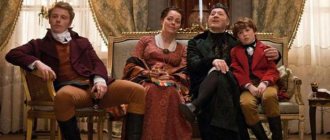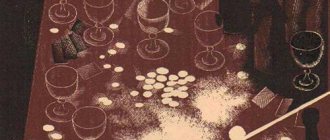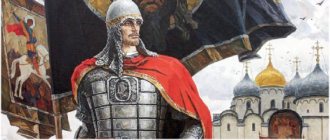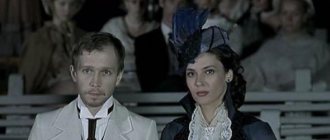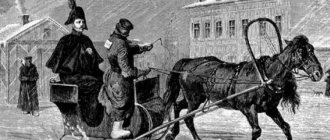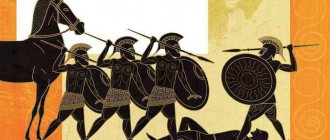The image of St. Petersburg in the works of N.V. Gogol
For a significant part of his life, N.V. Gogol spent in St. Petersburg. N.V. Gogol arrived in St. Petersburg as a nineteen-year-old youth in December 1828, and left it as a famous writer and playwright in December 1836. Subsequently, he came here only very briefly in 1838, 1841, 1842 and 1848. N.V. Gogol spent “one of the freshest and most impressionable eras of his life” in St. Petersburg, according to V.G. Belinsky.
Young N. Gogol passionately strives for St. Petersburg. He dreams, of course, of a new interesting life, which must certainly begin here. He dreams of a rented apartment overlooking the beautiful Neva. But you first have to settle in a modest area in the house of the pharmacist Trut near the Kokushkin Bridge, next to the Ascension Cathedral; soon on the fourth floor of house No. 39 on Bolshaya Meshchanskaya Street, to the house of the carriage maker Jochim. Gogol spoke about Meshchanskaya Street as follows: “The street of tobacco shops, German artisans and Chukhon nymphs.” It is curious that the euphemism “Chukhon nymphs” was invented by Gogol. Like all apartment buildings, the “House of Joachim” was densely populated by people of various classes. In one of his letters home, Gogol reports: “... the house in which I find myself contains two tailors, one marchand de fashion, a shoemaker, a hosiery manufacturer who glues broken dishes, a decater and a dyer, a confectionery, a small shop, a savings store a winter dress, a tobacco shop and, finally, a privileged midwife.” It's possible that you're lazy
By the time Gogol appeared in St. Petersburg, the formation of the main architectural ensembles of the city was completed. Thanks to the works of the largest architects of the late 18th – early 19th centuries. – K.I. Rossi, D. Quarenghi, A. Voronikhin, A. Zakharova. St. Petersburg acquired that “strict, slender look” that was glorified by A.S. Pushkin. The “sovereign flow” of the Neva, the “hulks of palaces and towers,” the spaces of majestic squares fascinated the young N.V. Gogol, with its austere beauty, reminded of the significant events that unfolded here. The Narva Gate, erected by D. Quarenghi for the ceremonial meeting of the Russian Guard, evoked the victories of the Patriotic War of 1812-1814, Senate Square - the suppression of the “December rebellion” of 1825.
St. Petersburg and St. Petersburg reality, communication with A.S. Pushkin and the writers of his circle, with outstanding cultural figures, formed Gogol the writer. Most of his works were conceived and written here. The St. Petersburg stories “Nevsky Prospekt”, “Nose”, “Overcoat”, “Portrait” reflected the unique originality of the city’s appearance. The comedies “The Inspector General” and “Marriage” were staged for the first time at the Alexandrinsky Theater. In articles and letters from writers devoted to issues of art and architecture in particular, in “Petersburg Notes of 1836”
N.V. Gogol, through the image of St. Petersburg, reflects on the fate of Russia, on the possible path of its development.
St. Petersburg made a stunning impression on the young N.V. Gogol with its majestic cold beauty. Of course, the city could not help but be reflected in his works. Moreover, St. Petersburg becomes not just a backdrop for the plots of N.V.’s works. Gogol, but an independent literary character, a literary hero.
St. Petersburg near N.V. Gogol has many faces and is changeable. If in “The Night Before Christmas” the city looks rather fairy-tale, magical, then in “The Overcoat” and “The Inspector General” the image of the city appears quite realistic, full of contrasts. In many ways, the same way A.S. Pushkin saw it earlier:
“The city is lush, the city is poor, The spirit of bondage, the slender appearance, The vault of heaven is green and pale, Boredom, cold and granite.”
Gogol depicted the most incredible Petersburg in Dead Souls. This is an absolutely unreal devilish city. Here the bridges, like devils, hang in the air without touching the ground. Curtains and curtains bite. There is some kind of devilish accumulation of people and things all around. From all this one gets the impression that St. Petersburg is a devilish city in which the “boss” is the rightful ruler, although there is a “higher authority.” In his waiting room sit not only poor people like Kopeikin, but also “epaulettes” and “aiguillettes”
One of Gogol’s first works in which the image of St. Petersburg is present is the story “The Night Before Christmas,” which was included in the cycle “Evenings on a Farm near Dikanka.” Here we see St. Petersburg through the eyes of Vakula. St. Petersburg seems something incredible to Vakula. Vakula is simply stunned by its radiance and thunder. Gogol shows Petersburg through sounds and light. The clatter of hooves, the sound of wheels, the trembling of bridges, the whistling of snow, the screams of cab drivers, the flight of carriages and sleighs - just incredible flashing and bustle. In this fairy-tale world, it seems to Vakula that even the houses come to life and look at him from all sides. Perhaps Gogol himself experienced similar impressions when he first arrived in St. Petersburg. About the unusually bright light that came from the lanterns, Vakula says: “My God, what a light! It’s never so light here during the day.”
The palace here is simply fabulous. All the things in it are amazing: the staircase, the painting; and even castles. The people in the palace are also fabulous: everyone wears satin dresses or gold uniforms. Vakula sees one shine and nothing more. In The Night Before Christmas, St. Petersburg is bright, dazzling, deafening and incredible in every way.
Petersburg looks completely different in the comedy “The Government Inspector”. Here it is much more real. It does not have the fabulousness that is present in “The Night Before Christmas”; it is almost a real city in which rank and money decide everything. In The Inspector General we encounter two stories about St. Petersburg: the story of Osip and the story of Khlestakov. In the first case, this is a story about normal Petersburg, which is seen by the servant of a minor official. He does not describe any incredible luxury, but speaks of real entertainment available to him and his master: theaters, dancing dogs and cab rides. Well, what he likes most is the fact that all people talk very politely: “Haberdashery, damn it, treatment!”
Khlestakov paints us a different Petersburg. This is St. Petersburg with veneration and unimaginable luxury. This is the St. Petersburg of the dreams of a petty official who wants to become a general and live in grand style. If at first he simply assigns himself a higher rank, then by the end of his story he is practically a field marshal, and his exaggerations reach truly incredible proportions: soup that arrived by boat from Paris, a seven-hundred-ruble watermelon. In general, St. Petersburg in Khlestakov’s dreams is a city where he has a lot of money and a high rank, so he lives in luxury and everyone fears and reveres him.
Petersburg is depicted somewhat differently in the story “The Overcoat”. This is a city where “little people” disappear without a trace. In it there are simultaneously streets where it is as bright as day at night, with generals living on them, and streets where slop is poured directly from the windows, where “shoes” live.
Gogol depicted the transition from one street to another through their lighting and the overcoats of officials. If on poor streets the lighting is “skinny” and a collar on an overcoat made of marten is rare, then the closer you get to rich areas, the brighter the light of the lanterns becomes and the more often you come across beaver collars.
“The Overcoat” describes the free time of petty officials and other poor people. So, some went to the theater or on the street, others for the evening, and still others to play cards and drink tea with some other official. The courtyard servants and “all sorts” of people sat in small shops in the evenings, spending time chatting and gossiping. Gogol talks about all this in contrast to Akaki Akakievich, whose entire entertainment consisted in copying papers. Rich people also go to the theater, walk the streets, play cards, but they buy more expensive tickets, dress better and, while playing cards, drink not only tea, but also champagne.
It's like two worlds of one city. They are very similar, but at the same time there are no less differences between them. These two worlds meet in the office of a significant person as Akaki Akakievich and the most significant person. And during this meeting, a significant person with his very appearance and voice almost killed the unfortunate Akaki Akakievich. So the rich part of the city, with the help of their money, completely subjugates the poor. The poor part of St. Petersburg is like a shadow of the second, rich part. They have similar outlines, but the shadow is gray and not colorful, while the rich city itself shimmers with all the colors of the rainbow.
The most popular place in St. Petersburg was Nevsky Prospekt. Developing along with the growth of St. Petersburg, Nevsky, its main communication, at the beginning of the 19th century was finally established as the front part of the city, as a favorite place for festivities of St. Petersburg residents. There are a huge number of images of Nevsky Prospekt! Among the most reliable portraits of Nevsky Prospekt is the famous panorama of V.S. Sadovnikova, which immediately after its first release in 1830, gained enormous popularity. It was bought both to decorate interiors and as a gift to friends. The most careful rendering of the architecture of the buildings and the multitude of everyday details and staff figures (portraits of the residents of the avenue) made this panorama a most valuable document of the era. It is known that in 1836 N.V. Gogol sent this image of the avenue to his mother in Ukraine.
N.V. also created a panorama of life on Nevsky Prospekt and its inhabitants. Gogol in the story “Nevsky Prospekt”. The main street of the Nicholas Empire was adopted by N.V. Gogol as a kind of “mirror” in which “the whole of St. Petersburg” was reflected. “There is nothing better than Nevsky Prospekt, at least in St. Petersburg; for him he is everything. Why doesn’t this beautiful street of our capital shine?” - the writer exclaims at the beginning of his story. “Oh, don’t believe this Nevsky Prospect!.. Everything is a deception, everything is a dream, everything is not what it seems!” - he concluded. The external splendor of the avenue did not obscure the sharp
the writer’s view of the contradictions “at all times” of the motley “noble, bureaucratic, merchant, lackey crowd” that fills it. It is no coincidence that the tragedy of the dreamy artist Piskarev, who could not withstand the collision of his idea of the ideal with the terrible reality, ensues here. Retired Major Kovalev rushes along Nevsky Prospekt in a strange environment of the real and the fantastic, chasing his own nose.
The pathos of the narrative, replete with enthusiastic emotional exclamations, constantly includes the author’s mockingly ironic reflections on the “wonderful” mustache, “not depicted by any pen or brush,” and on women’s waists, “no thicker than a bottle neck.” “God, what wonderful positions and services there are! How they elevate and delight the soul!” - the author exclaims, seemingly in complete delight, about officials who serve on a foreign board and are “distinguished by the nobility of their occupations and habits.” However, the author immediately adds: “But, alas! I do not serve and am deprived of the pleasure of seeing the subtle treatment of my superiors.” This author's irony becomes more and more frank, his admiration takes on a sarcastic character. Speaking about the “extraordinary nobility” and “self-esteem” of people walking along Nevsky Prospect, the author concludes: “Here you will meet a thousand incomprehensible characters and phenomena. Creator! What strange characters one meets on Nevsky Prospekt! There are many such people who, having met you, will certainly look at your boots, and if you pass, they will turn back to look at your coattails. I still can't understand why this happens. At first I thought that they were shoemakers, but, however, it didn’t happen at all: they mostly serve in different departments, many of them can write an excellent report from one government place to another; or, people engaged in walks, reading newspapers in pastry shops - in a word, for the most part, all decent people.” These “decent people” are actually idle slackers and hypocrites!
The small, timid official Akaki Akakievich, the main character of the story “The Overcoat,” had a dream in his life, for the sake of which he zealously served in one department. His dream is to buy an overcoat. He succeeded. But he did not have long to rejoice at his happiness. “Some people with mustaches” took his treasure in an endless square. The dark night of St. Petersburg in its boundless expanses destroyed the little man.
“Our poor story unexpectedly takes on a fantastic ending.” Near the Kalinin Bridge, a dead man, in the form of an official, was looking for the stolen overcoat and took it from passers-by. This seems true; You can read it in the newspaper - in the diary of incidents. However, the timid Akaki Akakievich is turned into a ghost by this ending. Gogol created the image of a victim of a huge and cold city, indifferent to the small joys and sufferings of its inhabitants.
Pushkin already posed this problem. But he affirmed the truth of the “non-human personality”, its great mission - to lead the Empire. Insignificant before her is the “rebellious slave” who boldly raised his hand against the Bronze Horseman: “He is already a miraculous builder!”
In Gogol we thus find the same theme, but the motive of “rebellion” is absent. This shows the complete humility of the little man. And his sympathies leaned entirely towards the victim. Gogol does not care about the big life of the providential city, which, for the sake of its unknown goals, depersonalizes its inhabitants, destroys them, like those in power. The theme put forward by Pushkin was revised by Gogol, and the city was condemned.
In the middle of the 19th century, a controversy arose between St. Petersburg and Moscow about the role and significance of these cities in the life of Russia. The dispute was essentially about the ways of development of the country as a whole. N.V. also took part in the controversy. Gogol. In the “St. Petersburg Notes of 1836,” written specifically for Pushkin’s Sovremennik, there are a number of statements that were included in the golden fund of St. Petersburg phraseology. For example:
“Moscow is feminine, St. Petersburg is masculine,” “In Moscow there are all brides, in St. Petersburg there are grooms,” “Russia needs Moscow, St. Petersburg needs Russia,”
“What a difference between the two of them! She still has a Russian beard, and he is already a neat German.” And everything here has exclamation marks, and “German” here is not a derogatory concept, but, on the contrary, complimentary. “A neat German” for the 19th and 20th centuries is a synonym for neatness, good quality, solidity, correctness, efficiency, and well-being. From Pushkin:
“And the baker, a neat German, in a paper cap, has already opened his vasisdas more than once.”
In articles and letters from writers devoted to issues of art and architecture (collection “Arabesques”) N.V. Gogol, through the image of St. Petersburg, reflects on the fate of Russia, on possible ways of its development. In the articles of N.V. Gogol, dedicated to issues of architecture, the appearance of the city of the Nicholas era is very recognizable.
Gogol loves the era of the Middle Ages, as if he yearns for its past beauty, which his contemporaries do not understand. He considers the classical architecture of his time boring and exclaims in his article “On the architecture of the present time”: “There was an extraordinary architecture, Christian, national for all of Europe - and we left it, forgot it, as if it was alien, neglected it as clumsy and barbaric.”
Gogol did not like the architecture of classicism; no architectural structure of this style aroused in Gogol not only admiring, but even positive assessment. “All city buildings began to be given a completely flat, simple shape. They tried to make the houses as similar to each other as possible; but they looked more like barns or barracks than the cheerful dwellings of people.”
N.V. Gogol emphasizes the utilitarianism of his contemporary architecture. According to the writer, in the appearance of buildings there should be combustion, light, expressed in the very architecture of the building, like a medieval temple, the building of which “flew to the sky; narrow windows, pillars, vaults stretched endlessly into the heights; narrow windows, pillars, vaults stretched endlessly into the heights; a transparent, almost lacy spitz, like smoke, shone over them.”
The writer was also not satisfied with modern “temple building”. He especially accused architects of petty imitation of antiquity and Western art, when they cannot grasp the whole idea, but only grasp at the particulars.
“A creative architect must have deep knowledge of all types of architecture. He should least of all neglect the taste of those peoples whom we despise in regard to the arts. It must be comprehensive, study and accommodate all their countless changes. But the most important thing is that he must study everything in the idea, and not in the petty external form and parts. But in order to study an idea, he needs to be a genius and a poet,” this is the writer’s credo.
Petersburg N.V. Gogol is in many ways different from Pushkin’s Petersburg, “The Bronze Horseman” and “The Queen of Spades”, with its strict straightness of streets and squares, the grandeur and beauty of the city, built by the daring will of the transformer of Russia, Peter I.
Gogol shows Petersburg of petty officials and “significant persons”, bureaucratic offices and gloomy apartment buildings, the gloomy inhumanity of the capital, which the brilliant but “lying exhibition” of Nevsky Prospect cannot cover up. This is a city of “boiling commercialism”, parades, officials.
In a letter to his mother dated April 30, 1829, Gogol wrote about the alien, non-national character of the capital: “Petersburg is not at all like other European capitals or Moscow. Each capital is generally characterized by its people, who cast the stamp of nationality on it, but St. Petersburg has no character at all: the foreigners who settled here have settled down and are not at all like foreigners, and the Russians, in turn, have become more common and have become neither one nor the other.”
It was against this inner world of St. Petersburg, St. Petersburg, disfiguring human souls, bureaucratic-nationalless, coldly dispassionate, subordinating all life functions to rank, “mercantilism,” that the writer spoke out in his works, written in defense of the “simple” little man from an insignificant, barren life, to which the city condemned the departments and the power of money.
Not everyone can see the inner world of St. Petersburg, but only a few, special people. One of these people was Gogol. He saw in this city something that the people living here had not noticed for centuries. Nabokov wrote: “Petersburg revealed all its quirkiness when the most bizarre person in all of Russia began to walk along its streets.”
THE TRAGIC FACE OF ST. PETERSBURG IN N. V. GOGOL’S STORY “Nevsky Prospekt”
Student's work. As a young man, Gogol came from his native Little Russia to St. Petersburg and in a short time managed to get acquainted with the life of capital officials and St. Petersburg artists - his future characters. The writer seemed to repeat this route, transferring the “world” of his work from Dikanka and Zaporozhye Sich to Nevsky Prospekt. Subsequently, the third “geographical region” of Gogol’s work will be the deep Russia of “The Inspector General” and “Dead Souls.” And Gogol’s heroes travel in the same directions, connecting different periods and “worlds” of his work with each other: the blacksmith Vakula from “Evenings on a Farm near Dikanka” flies to St. Petersburg riding on a line, Khlestakov from the capital is an “auditor” in the district wilderness...
“It is difficult to grasp the general expression of St. Petersburg,” Gogol wrote in the article “Petersburg Notes of 1836,” because in this city disunity prevails: “it seemed as if a huge stagecoach had arrived at the tavern,” in which each passenger sat closed the whole way and entered the common hall only because there was no other place.” The capital is like a big inn, where everyone is on their own and no one knows each other. How different this image is from the “general expression” of the farmstead or the fair of Gogol’s “Evenings”! Here we read in the finale of the Sorochinskaya Fair:
“A strange, inexplicable feeling would take possession of the viewer when he saw how, with one blow of the bow of a musician in a dress, with a long curled mustache, everything turned, willy-nilly, to unity and passed into agreement... Everything rushed. Everyone was dancing.
And now before us is Nevsky Prospekt - “the general communication of St. Petersburg.” At the beginning of the story of the same name, the life of this main street of the main city is shown constantly 24 hours a day. The picture is full of movement, but each person and in different “circles and circles” has his own movement at his own time; all are combined only by place - Nevsky Prospekt. Here, too, “everything is rushing,” but in a different way than at the Sorochinskaya Fair. In Gogol, we notice how often he uses generalizations: “everything” or his favorite “everything that is not.” We can say that this concept was the formula of his ideal, his idea of something harmonious and whole. In the folk world of “Evenings” and “Taras Bulba” this Gogolian “everything that is not” sounds sublime - here it embraces, as it were, a single grandiose personality of an entire collective. But then Gogol began to measure his Nevsky Prospect with this yardstick, and it became filled with emptiness, and the all-encompassing became inflated and comical. It now illuminated the internal structure of the socially and humanly divided St. Petersburg world.
“Everything that you will not meet on Nainevsky Prospekt...”, namely: “You will find the only sideburns here... Here you will meet an amazing mustache...”. In these exorbitant praises, expressed in superlatives, the reader hears falsehood. It seems that the same exclamatory, enthusiastic intonation sounded in “Evenings”, and it can be heard now. But now, behind the delight, we hear irony, and in the very intonation of praise on the first page of the story, we can already hear what the author will say in the end: “Oh, don’t believe this Nevsky Prospect.” So immediately “the tone makes the music”; In this discrepancy between intonation and content, we immediately perceive “by ear” the discrepancy between external and internal - the theme of the entire story “Nevsky Prospekt”.
In “The Night Before Christmas,” Vakula, visiting St. Petersburg, expressed his “fairy-tale” impressions with the following words: “amazing proportion. In the Petersburg story, the strangely excited “proportion” catches our eye. The “amazing mustache,” representing “everything,” stands out from the whole picture and takes up a huge amount of space. And in general, on Nevsky Prospect, instead of people, some external signs - appearance, position in society - grow and become “everything”. And since ideas about dignity, value and significance merge with everything that we see, this is the source of confusion and “nonsense.” The reader feels a disproportion in the author’s story, too, as if the correct “proportion”, the relationship between the part and the whole, the significant and the small, the important and the insignificant, are confused here too. Everything is possible in this world. In the narrative itself, we notice a certain strange logic: every now and then the important “everything” turns into an empty “nothing”; for example, about Lieutenant Pirogov’s talent for making girls laugh, it is said that “this requires great art or, better said, no art at all.”
The “internal structure” of the world of St. Petersburg stories is revealed to us through the eyes of Piskarev: “It seemed to him that some demon, having scrambled the whole world into many different pieces and all these pieces without meaning, had senselessly mixed them together.” But the “demonic” picture is no longer a funny picture. The fragmented “fantastic” reality in Gogol has two sides, two faces: one of them is vulgar, comic, the other is tragic.
In Gogol's story there is Nevsky Prospekt during the day and at night. During the day This is an exhibition where the “sideburns alone” represent the whole person. Evening lighting gives rise to new points of view and new problems. From the evening lantern, the artist Piskarev and Lieutenant Pirogov diverge in different directions, two parallel plot lines, on the comparison of which Nevsky Prospekt is built. One is attracted by beauty, another by intrigue; Failure awaits both, and each experiences his defeat in his own way and finds his own way out: one dies, the other continues to live, easily forgetting the shame and disgrace over pies in the pastry shop and the evening mazurka.
Such different readers of Gogol as Belinsky, Apollon Grigoriev and Dostoevsky equally admired his Pirogov, the “immortal” image of vulgarity. We all understand the tragic meaning of this plot and life parallel between the fragile inability to come to terms with the imperfections of life and the Triumphant vulgarity that “you can’t get through anything. “The eternal conflict between dreams and reality,” exclaims Gogol’s artist. However, Gogol himself only half connects his voice with this cry of a romantic who does not want to see reality, sleeps in reality and lives in a dream in order to hold on to his dream. But what is his dream? After all, it originates right there, on Nevsky Prospekt: Piskarev’s stranger, “Petrudzhinova Bianco,” was born from the incorrect night lighting, from which long shadows crawl onto the pavement, reaching with their heads to the Police Bridge. Gogol gives an amazing picture of the city at night, how he seems to be behind his dream and the artist, clouded by this flight:
“The sidewalk rushed under him, the carriages with the horses that galloped seemed motionless, the city stretched and broke on its arch, the house stood down, the booth fell towards it, and the sentry’s halberd, along with the golden words of the sign and the painted scissors, seemed to shine on the eyelash itself. Piskarev’s dream, a beautiful lady, so cruelly deceived by an illusion, also belongs to this world of nighttime St. Petersburg fantasy. At the conclusion of the story, the words “dream” and “deception” are combined: “Everything is a deception, everything is a dream, everything is not what it seems.”
To understand Gogol, you need to listen well to his unusual broadcasts. In Nevsky Prospekt it spreads into two streams moving in parallel channels of the plot. The author combines his voice first with the artist Piskarev, sometimes with Lieutenant Pirogov, and therefore in different places he says opposite things on the same topic and in completely different tones: He speaks openly in the final monologue, “removing” both intonations he has assumed and summing up with his voice the result of the parallel action: “Everything is not what it seems... He lies about everything, this Nevsky Prospekt...”.
Pushkin found very true words when he called Gogol’s “Nevsky Prospekt” the most complete of his works. In fact, the artistic essence of this story combines Gogol’s comedy and Gogol’s lyricism, the vulgarity and the tragic personality of Gogol’s Petersburg.
the content of this plot and life parallel between the fragile inability to come to terms with the imperfection of life and the triumphant vulgarity that “nothing will break through. “The eternal conflict between dreams and reality,” exclaims Gogol’s artist. However, Gogol himself only half connects his voice with this cry of a romantic who does not want to see reality, sleeps in reality and lives in a dream in order to hold on to his dream. But what is his dream? After all, it originates right there, on Nevsky Prospekt: Piskarev’s stranger, “Petrudzhinova Bianco,” was born from the incorrect night lighting, from which long shadows crawl onto the pavement, reaching with their heads to the Police Bridge. Gogol gives an amazing picture of the city at night, how he seems to be behind his dream and the artist, clouded by this flight:
“The sidewalk rushed under him, the carriages with the horses that galloped seemed motionless, the city stretched and broke on its arch, the house stood down, the booth fell towards it, and the sentry’s halberd, along with the golden words of the sign and the painted scissors, seemed to shine on the eyelash itself. Piskarev’s dream, a beautiful lady, so cruelly deceived by an illusion, also belongs to this world of nighttime St. Petersburg fantasy. At the conclusion of the story, the words “dream” and “deception” are combined: “Everything is a deception, everything is a dream, everything is not what it seems.”
To understand Gogol, you need to listen well to his unusual broadcasts. In Nevsky Prospekt it spreads into two streams moving in parallel channels of the plot. The author combines his voice first with the artist Piskarev, sometimes with Lieutenant Pirogov, and therefore in different places he says opposite things on the same topic and in completely different tones: He speaks openly in the final monologue, “removing” both intonations he has assumed and summing up with his voice the result of the parallel action: “Everything is not what it seems... He lies about everything, this Nevsky Prospekt...”.
Pushkin found very true words when he called Gogol’s “Nevsky Prospekt” the most complete of his works. In fact, the artistic essence of this story combines Gogol’s comedy and Gogol’s lyricism, the vulgarity and the tragic personality of Gogol’s Petersburg.
